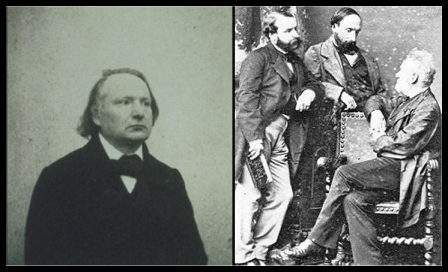Victor Hugo Photo Album
Here’s one very interesting article, The Victor Hugo Album, that I was reading online today on Victor Hugo’s birthday. It appears in an issue of IMAGE, Journal of Photography of the George Eastman House (October 1952, Vol. 1, No. 7). I reproduce it for you here only to make it easier to read.
“In the Gabriel Cromer Collection in the George Eastman House there is an album of photographs of Victor Hugo and his circle.
Bound in morocco leather, it contains forty photographs made between 1852 and 1854, while Hugo was in exile on the Isle of Jersey. An ardent supporter of the new and struggling Republic, he had fled France after the coup d’etat of Napoleon III, when a reward of 25,000 francs was placed on his head for publicly denouncing the policies of the Emperor. The photographs were taken by the poet’s son Charles and Auguste Vacquerie, who went with the patriot to his Jersey refuge at Marine Terrace. The album was composed by Victor Hugo, and his wife, Adele Hugo, to be sent to Euphemie Barbier, whose initials are embossed in gold on the cover. She was the daughter of Dr. Barbier who, with his wife, was also at Jersey and lived in the Hugo home.
It forms a touching document to the life of Victor Hugo during that tragic time. It also provides an extraordinary example of early photography as the aesthetic expression of a great personality. Victor Hugo himself did not touch the equipment which was used in making the collection of pictures in this album, but he supervised the procedures and posed for a number of the photographs. Through the crude mechanics of the apparatus then available; through the chemistry of the early albumen and collodion processes, through the inexperienced work of Charles Hugo and August Vacquerie who were sensitive and obedient to his instructions, Hugo’s poetic artistry is unmistakenly revealed. One finds in these prints the same “light against dark,” the same tragic humor and much the same type of feeling for landscape and figures which appear in the Victor Hugo paintings and drawings. The talented Hugo family had led a life in France full of social and patriotic activity, as well as intensive work in the fields of art and literature. Victor Hugo was able to use much of his energy while in exile writing, but Charles Hugo and Vacquerie found time hanging heavily on their hands. Photography offered a diversion in which everyone could participate. Charles journeyed to Caen where he studied with experts, and returned with some knowledge of the albumen process. Vacquerie mastered the techniques involved in using collodion. They were delighted with the simplicity of these processes compared with the complexities of making daguerreotypes. Friends sent the necessary materials. The two ‘operators’ became proficient in handling their tools, and Hugo’s imagination leaped quickly to the potentialities of this new “sun painting.” The album contains several portraits of him, and a number of landscape studies for which he posed as the tragic exile on the rocks of the wild Jersey coast.
In the volume is the famous photograph of Hugo’s hand, and another of the beautiful hand of his wife. There are many pictures of companions in exile and their children. These are done with dignity and tenderness, and the discerning eye perhaps can see in them the influence of the artist Hugo most admired, ‘O Durer, master mind, painter old and pensive!’, whose work is reflected in the poet’s own paintings.
A picture of the Hugo home at Marine Terrace is included, and a detail of the house shows Hugo at an upstairs window, with Charles at another, looking out over the greenhouse where Madame Hugo rested when the family returned from the afternoon walks. In a letter which accompanied the ‘souvenir’ Madame Hugo regrets that Vacquerie was unable to find a print of Madame Barbier to add to the collection. Apparently the filing problems of amateurs were the same a hundred years ago.
Later Vacquerie used some of the photographs in making up a more pretentious volume called Profiles et Grimaces, which was sent to Madame Paul Meurice, the wife of one of Hugo’s closest friends. Victor Hugo is well known as a novelist, poet, essayist play-wright and patriot. A few are aware of his ability as an artist.
The pictures in this album reveal him as a versatile genius who intuitively grasped the potentialities of photography as an art expression. It is fortunate that these beautiful prints of the simple scenes around his home at Marine Terrace and the faces of those in exile dear to him, are preserved in this volume. The Victor Hugo Album is indeed a rare photographic treasure.”
Another thing I saw was a photograph that was taken by Auguste Vacquerie. There it is on the left.

On the right is (from left to right) Hugo’s son, Francois and Auguste Vacquerie with Hugo (sitting down).
Auguste’s brother, Charles married Victor Hugo’s daughter, Leopoldine. The couple were both tragically killed in a boating accident on September 4, 1843.
Descendants of the Vacquerie family sold its traditional family home and garden in the town of Villequiers to the Seine Maritime department in 1951, and it was opened to the public in 1959. Check that out on this page. (It’s in French)
Auguste Vacquerie died about 10 years after Victor Hugo. His death was reported in the New York Times and mentions that he was Hugo’s literary executor and also one of the guardians of Hugo’s grandchildren, Georges and Jeanne.



Recent Comments